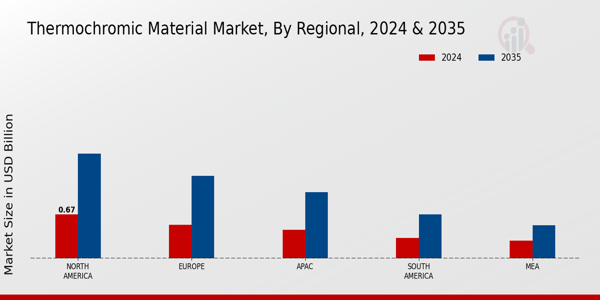Market Growth Projections
Rising Interest in Smart Textiles
The fashion and textile industries are increasingly exploring the potential of thermochromic materials, leading to the emergence of smart textiles. These materials can change color in response to temperature variations, offering unique design possibilities and interactive experiences for consumers. The Global Thermochromic Material Market Industry is likely to see substantial growth as designers and manufacturers embrace these innovative materials to create dynamic clothing and accessories. This trend aligns with the broader movement towards personalization and technological integration in fashion, potentially contributing to the market's expansion.
Innovations in Packaging Solutions
The Global Thermochromic Material Market Industry is witnessing innovations in packaging solutions, particularly in food and beverage sectors. Thermochromic inks are employed in packaging to indicate temperature changes, ensuring product quality and safety. For example, packaging that changes color when exposed to certain temperatures can alert consumers to spoilage or improper storage conditions. This application not only enhances consumer safety but also aligns with sustainability trends, as companies seek to reduce waste. As the market evolves, the integration of these materials in packaging is expected to drive significant growth.
Expansion in Automotive Applications
The automotive sector is increasingly adopting thermochromic materials for various applications, including interior and exterior components. These materials can change color based on temperature, providing both functional and aesthetic benefits. For instance, thermochromic coatings are utilized in vehicle exteriors to enhance visual appeal while also serving practical purposes such as temperature regulation. The Global Thermochromic Material Market Industry is likely to benefit from this trend, as the automotive market continues to evolve towards more innovative and sustainable solutions, contributing to the anticipated growth trajectory.
Growing Demand in Consumer Electronics
The Global Thermochromic Material Market Industry is experiencing a surge in demand driven by the increasing integration of thermochromic materials in consumer electronics. Devices such as smartphones and tablets utilize these materials for aesthetic and functional purposes, enhancing user experience. As of 2024, the market is valued at approximately 2.19 USD Billion, reflecting a growing trend towards personalization and innovative designs in electronics. This demand is expected to escalate as manufacturers seek to differentiate their products in a competitive landscape, potentially contributing to the projected growth of the market.
Regulatory Support for Sustainable Materials
The Global Thermochromic Material Market Industry is benefiting from regulatory support aimed at promoting sustainable materials. Governments worldwide are implementing policies that encourage the use of environmentally friendly materials in various industries, including construction, automotive, and consumer goods. This regulatory landscape is likely to drive demand for thermochromic materials, which often offer sustainable alternatives to traditional options. As the market evolves, the alignment of thermochromic materials with sustainability goals may enhance their attractiveness to manufacturers and consumers alike.

















